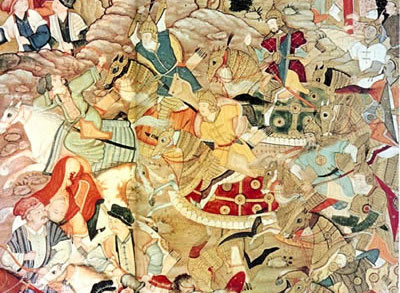
Illustration from History of the Moghuls, a 17th-century Indian text (detail), Gulestan Palace Library, Tehran
The major lessons that Chinggis Khan learned from the hardships of his early years (his father's untimely death forced his mother to eke out a survival for the family in the harsh desert lands of Mongolia) convinced him that no one could survive in the daunting landscape of Mongolia without maintaining good relations and seeking help on occasion from one's allies. Chinggis's earliest experiences thus convince him of the importance of forging alliances. [For more on Chinggis's early life, see Key Figures in Mongol History: Chinggis Khan]
One's anda (blood brother) pricked his finger and mixed blood with one to forge a blood brotherhood. Chinggis found many andas, and his blood brothers, realizing his superior abilities and his charisma, would often join under his banner.
Early in his rise to power, Chinggis attempted immediately to break down the tribal groups that joined him, because he felt that loyalty in the tribal group would belong to the tribal leader rather than to himself. He wanted to eliminate any feeling of tribal identity and convert it to a Mongol identity — a unit that would be much larger, greater than that of the tribe, wherein the loyalty would remain with him, rather than with a tribal leader. Thus, when a tribe did join him, he quickly dispersed its members through the various units that he controlled. [Also see Key Figures in Mongol History: Mongol Unity under Chinggis Khan]